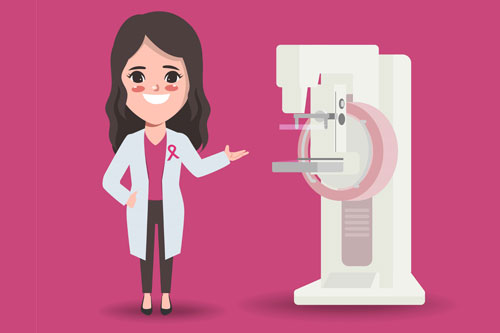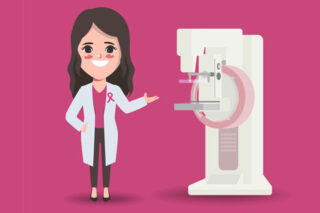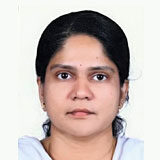How to Select a Mammography Centre In 3 Easy Steps

How to Select a Mammography Centre In 3 Easy Steps
Dr. Rekha Narayanan, MBBS, DMRD, DNB (Radiodiagnosis), Consultant Radiologist
India’s Leading Mammography Expert
 You deserve access to the best of technology & facilities when it’s time for your annual mammogram.
You deserve access to the best of technology & facilities when it’s time for your annual mammogram.
You may have many options at your place to get a mammogram done. For example, a diagnostic lab, a hospital, or a dedicated breast clinic.
How to select one among all available choices?
Worry not! Here are three easy steps to help you navigate well in choosing the right Mammography Centre:
1. Does the Centre have Digital Mammography or only the old, film-based Analogue Mammography?
Mammography technology has made rapid progress in recent years to enable speedier and more comfortable mammograms at much lower radiation doses than ever before.
In older analog mammography, the films were used to capture images. Remember the old cameras with film roles? Something like that.
In the newer digital mammography, the image is directly captured by the computer, which can be magnified, enhanced, etc., for further evaluation when needed.
There are more advantages of Digital Mammography machines over Analogue machines.
- The cancer detection rate is significantly higher (21% more) in digital mammography than in analog.[1]
- Much less radiation (averaging 22% lower) is used by digital mammography vs analog.[2]
- Digital imaging is faster than analog which means a woman’s breasts are compressed for less time.
- Digital images are immediately available for the doctors. There is no waiting time for film development.
2. Is 3D Mammography available at the Centre?
- The latest 3D mammography machines in the digital mammography family are designed to deliver the fastest and the highest resolution mammograms, with more comfort, and at the lowest radiation dose within the allowable limits.
- Studies have shown that 3D mammography significantly helps in early breast cancer detection, enabling the detection of more cancer cells[3], and significantly reducing recall rates[4] for any additional tests.
- 3D mammography is especially useful in high-risk women, i.e., including those with:
- Changes or lumps in the breasts
- A family history of breast or ovarian cancer[5]
- Dense breast tissue has risk for breast cancer
- A previous diagnosis of breast disease
3. Does the Centre have other relevant capabilities for Mammography?
- Radiologists are specialist medical doctors who study your mammograms and interpret the scans for you. Usually, the website of the Centre will have detailed information about the doctor’s qualifications, experience, advanced training or fellowship in radiology, etc. This may give you a good idea about the professional expertise at the Centre.
- Mammography is only an imaging test that has no cuts, pricks, or requires admission to hospital, etc. You can either take a prior appointment or walk in if the Centre advises so for mammography that usually takes only a few minutes excluding waiting time. Within those few minutes too, your breast tissue will be compressed only for less than 10 seconds in the latest 3D Mammography machines to take clear images and avoid recalls.
- Most health plans cover the cost of mammography if you are insured for diagnostic tests. Even if not, the cost of mammography is negligible compared to the benefits it provides.
Never miss your annual mammogram:
- No one is immune to breast cancer. No one can prevent it. Early detection with routine screening is the best protection. All women carry at least an average risk of breast cancer after puberty, with increasing risk as you age.
- About 50% of breast cancers develop in women with no identifiable risks other than gender and age.[6] Some women are at higher risk than this due to family history, breast density, genetics, personal history of breast disease, obesity, smoking, etc.
- Mammography is the gold standard test for early breast cancer detection.[7] Breast cancer deaths are reduced by 30% to 50% with annual screening mammography performed on all women beginning at age 40 years.[8]
- The other perceived alternatives such as Self Breast Examination, Ultrasound, etc., are not recommended by most medical organizations across the world. Click here to find out why.
- Annual screening mammograms can substantially reduce your stress & medical expenses: Just like car insurance premiums, spending a small amount on mammography every year may help you save 30% to over 100% of the treatment costs of breast cancer compared to the women who are diagnosed with advanced-stage breast cancers7. You may avoid the need for chemotherapy, removing the entire breasts, etc., with early detection with mammography.
- Hence, it’s very important and highly beneficial for you to schedule prompt yearly mammograms to detect breast cancer when it is very small in size, and very much confined to the breast alone.
If you are eligible for breast screening either by age (40 years and above) or due to high-risk factors such as family history (in which case even if you are younger than 40 years), get your first mammogram now, and immediately subscribe to an Annual Screening Mammography plan – A simple ritual that can save your life!

Dr. Rekha Narayanan,
MBBS, DMRD, DNB (Radiodiagnosis), Consultant Radiologist
Aster MIMS Hospital, Calicut, Kerala
- Hambly NM, McNicholas MM, Phelan N, Hargaden GC, O’Doherty A, Flanagan FL. Comparison of Digital Mammography and Screen-Film Mammography in Breast Cancer Screening: A Review in the Irish Breast Screening Program. American Journal of Roentgenology. 2009;193(4):1010-1018. doi:10.2214/ajr.08.2157
- Hendrick RE, Pisano ED, Averbukh A, et al. Comparison of Acquisition Parameters and Breast Dose in Digital Mammography and Screen-Film Mammography in the American College of Radiology Imaging Network Digital Mammographic Imaging Screening Trial. AJR American journal of roentgenology. 2010;194(2):362. doi:10.2214/AJR.08.2114
- Skaane P, Bandos AI, Gullien R, et al. Comparison of Digital Mammography Alone and Digital Mammography Plus Tomosynthesis in a Population-based Screening Program. Radiology. 2013;267(1):47-56. doi:10.1148/radiol.12121373
- Rose SL, Tidwell AL, Bujnoch LJ, Kushwaha AC, Nordmann AS, Sexton R. Implementation of Breast Tomosynthesis in a Routine Screening Practice: An Observational Study. American Journal of Roentgenology. 2013;200(6):1401-1408. doi:10.2214/ajr.12.9672
- https://www.canceraustralia.gov.au/sites/default/files/publications/breast-cancer-risk-factors-review-evidence/pdf/rfrw-breast-cancer-risk-factors-a-review-of-the-evidence_1.15.pdf Accessed 16 Sep 2022
- https://www.who.int/news-room/fact-sheets/detail/breast-cancer Accessed 16 Sep 2022
- https://www.webmd.com/breast-cancer/features/mammography-still-gold-standard-for-breast-cancer Accessed on 23 Aug 2022.
- Feig S. Comparison of Costs and Benefits of Breast Cancer Screening with Mammography, Ultrasonography, and MRI. Obstetrics and Gynecology Clinics of North America. 2011;38(1):179-196. doi: 10.1016/j.ogc.2011.02.009
